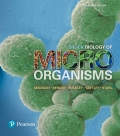
Brock Biology of Microorganisms
15th Edition
ISBN: 9780134626352
Author: MADIGAN
Publisher: PEARSON
expand_more
expand_more
format_list_bulleted
Question
Chapter 23.6, Problem 1MQ
Summary Introduction
About one million of insect species are known today. They are the most abundant class of living animals. More than 20% of insects support symbiotic microbes. This symbiotic association contributes the insect’s ecological success by protecting and providing nutritional benefits. The symbionts are found either in outer surface or inner digestive tracts of the insects. Insect symbionts can be transmitted vertically or heritably (from parent to offspring) or horizontally, depending mostly upon the specificity and persistence of the mutualistic association.
Expert Solution & Answer
Want to see the full answer?
Check out a sample textbook solution
Students have asked these similar questions
what is the only known coccidial parasite that does not have intermediate hosts?
What factors might eventually limit the exponential growth rates of a particular insect speciesfound in such regions as the Canadian prairies?
How does the insect circulatory system carry out physiological insect defence mechanisms? Is there a relationship between the size of the insect and the level of defense?
Chapter 23 Solutions
Brock Biology of Microorganisms
Ch. 23.1 - What two microbes form a partnership in the lichen...Ch. 23.1 - Prob. 2MQCh. 23.1 - Prob. 1CRCh. 23.2 - What is the evidence that "Chlorochromatium...Ch. 23.2 - Prob. 2MQCh. 23.2 - How might nutrients be shuttled between phototroph...Ch. 23.2 - QWhat mechanisms do the consortia use to orient at...Ch. 23.3 - Prob. 1MQCh. 23.3 - Prob. 2MQCh. 23.3 - What is a bacteroid and what occurs within it?...
Ch. 23.3 - What are the major similarities and differences...Ch. 23.3 - QDescribe the steps in the development of root...Ch. 23.4 - Prob. 1MQCh. 23.4 - Prob. 2MQCh. 23.4 - How do mycorrhizal fungi promote plant diversity?Ch. 23.4 - Prob. 1CRCh. 23.5 - Prob. 1MQCh. 23.5 - How do the vir genes differ from T-DNA in the Ti...Ch. 23.5 - How has an understanding of crown gall disease...Ch. 23.5 - Prob. 1CRCh. 23.6 - Prob. 1MQCh. 23.6 - What are the consequences of symbiont genome...Ch. 23.6 - How could it be determined if a symbiont and its...Ch. 23.6 - QHow is it possible for aphids to feed only on the...Ch. 23.7 - How are anoxic conditions maintained in the...Ch. 23.7 - Why does reductive acetogenesis predominate over...Ch. 23.7 - Prob. 3MQCh. 23.7 - QHow do the microbial communities of higher and...Ch. 23.8 - Prob. 1MQCh. 23.8 - Prob. 2MQCh. 23.8 - How is the correct bacterial symbiont selected in...Ch. 23.9 - Prob. 1MQCh. 23.9 - What are the similarities of the obligate...Ch. 23.9 - Prob. 3MQCh. 23.9 - Prob. 1CRCh. 23.10 - What evidence suggest that the nematodes and their...Ch. 23.10 - What prevents other bacteria from colonizing the...Ch. 23.10 - QWhy are entomopathogenic nematodes so attractive...Ch. 23.11 - Prob. 1MQCh. 23.11 - What are the two mechanisms of Symbiodinium...Ch. 23.11 - Prob. 3MQCh. 23.11 - Prob. 1CRCh. 23.12 - Prob. 1MQCh. 23.12 - Prob. 2MQCh. 23.12 - Prob. 1CRCh. 23.13 - Prob. 1MQCh. 23.13 - Prob. 2MQCh. 23.13 - Prob. 3MQCh. 23.13 - QGive an example of a single microbial species...Ch. 23 - Imagine that you have discovered a new animal that...Ch. 23 - Prob. 2AQ
Knowledge Booster
Learn more about
Need a deep-dive on the concept behind this application? Look no further. Learn more about this topic, biology and related others by exploring similar questions and additional content below.Similar questions
- Name the pests that lady bird & dragon flies help to get rid off respectively?arrow_forwardWhich nematode infects the roots of tobacco plant and causes a great reduction in yield?arrow_forward(a) What species of blood fluke causes Schistosomiasis in the Philippines? (b) What species of freshwater snail is its intermediate host?arrow_forward
- How does the parasite affect the host in a way that it hastens the progress of its life cycle? explain furtherarrow_forwardWhat is insect impact on plants and animals and why is it important to be able to identify them?arrow_forwardDescribe the life cycle of the parasitic nematode? What is the advantage of it making an infected ant's butt big and bright red?arrow_forward
arrow_back_ios
SEE MORE QUESTIONS
arrow_forward_ios
Recommended textbooks for you

Parasites: Protozoa (classification, structure, life cycle); Author: ATP;https://www.youtube.com/watch?v=V4iSB0_7opM;License: Standard youtube license